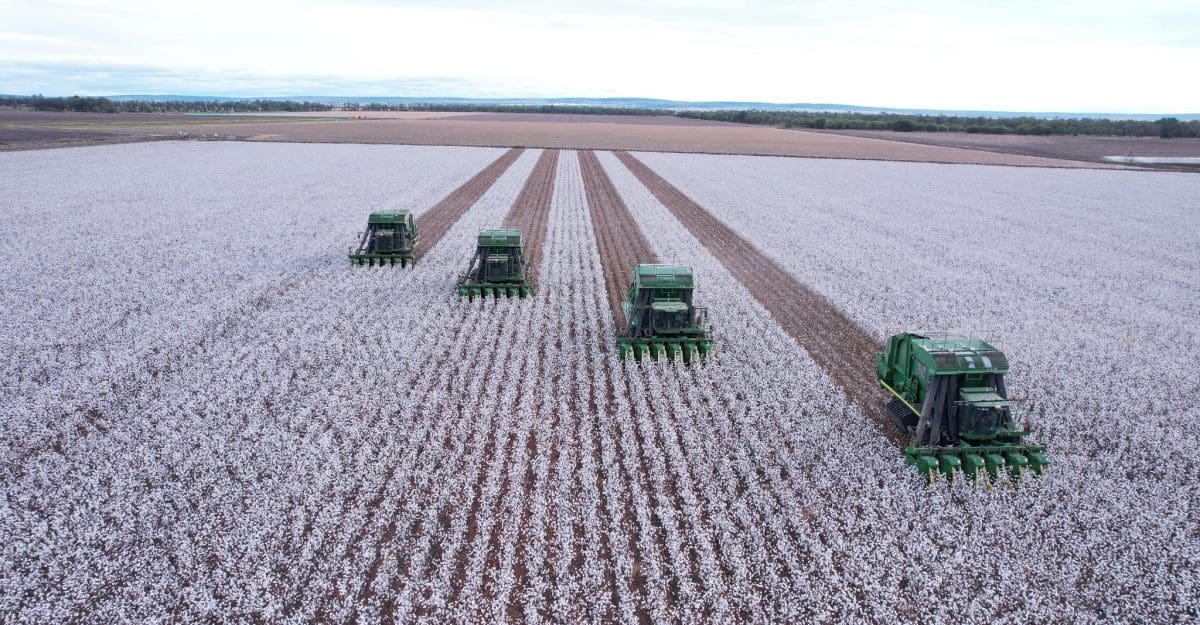
Picking cotton in Central Queensland this season. Photo: Michelle Hutchinson, Hutchinson Ag
AROUND 85 percent of the Australian cotton crop has now been picked with growers and cotton gin operators reporting better-than-expected yields and some cases of exceptional quality.
Cotton Australia general manager Michael Murray said indications are that the crop now being picked will fall short of last year’s record-yielding crop of 5.6 million bales.
“With good rainfall leading to healthy soil profiles and good water storage results, we had forecast a positive result in 2022 and we achieved some of the best yields on record in some areas,” Mr Murray said.
“That rainfall became a problem in parts of New South Wales and southern Queensland in late 2022, with severe flooding recorded in many growing areas as well as crop and infrastructure damage.”
Mr Murray said conditions at that point led to a downgrade in expectations, but the quality of the crop ginned and classed to date has been exceptionally high with clean and white lint of good fibre length and strength.
“I’m pleased to say that better conditions, including a warmer-than-expected start to 2023, resulted in a boost for growers and the results are now becoming clear.
Cotton quality is measured by a variety of factors including the colour, strength, contamination by leaf and other plant matter, staple length and micronaire, which is a measure of fibre maturity.
Mr Murray said the timing for Australian growers is good with crops processed through gins lining up with the increased shipping capacity as shipments traditionally ramp up through to September.
“Industry forecasts suggest that while US and Brazilian cotton is being traded at significant volumes to some of our trading partners, our cotton is considered to be of the best value when you take into consideration the quality, the lower transportation costs and the turnaround times.”
The crop results come as the growing footprint of cotton in Australia continues to expand as more growers consider cotton in North Queensland, the Northern Territory and north-west Western Australia.
Mr Murray said cotton can grow across a wide geographical range and climatic conditions, with scope for growth in many areas north of the Victoria-NSW border.
“We are hearing reports of growers in coastal Queensland locations adding cotton to their rotations and doing very well.
“While some areas are considered ideal because of the rainfall and temperatures, cotton can thrive in other conditions and provide a profitable alternative.
“Some growers see the lack of nearby cotton gins as an issue, but with a gin close to completion in the NT, a commitment to build one in the Ord River area, and plenty of positive industry talk about one for North Queensland, those transport costs will become less of an impediment.”
It has also been a record year for the production of myBMP cotton with over a third of the crop certified under the program. myBMP cotton also qualifies as Better Cotton under an agreement between BC and CA.
Mr Murray said important consultation is advanced across the industry as part of the roadmap process that is looking at some of the key issues confronting the industry.
Cotton Australia, the Australian Cotton Shippers Association and the Cotton Research and Development Corporation are jointly developing a strategic roadmap for the Australian cotton industry.
Mr Murray said this will that will help the industry remain competitive in a changing fashion and textiles market.
The roadmap is addressing broad consultation across industry, farmers and stakeholders: traceability, industry data, sustainably certified cotton/myBMP program and Australian cotton marketing.
Mr Murray said the global market remains very positive for our cotton overseas.
“We sell every bale we grow, so clearly the global demand is there, and as global economic conditions improve, so too will demand for our cotton which is seen as among the highest quality produced.”
Source: Cotton Australia

HAVE YOUR SAY